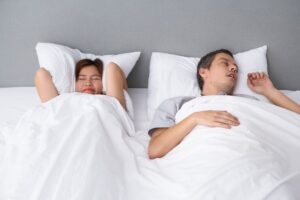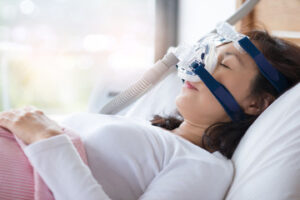Do Oral Appliances Really Help in Treating Sleep Apnea?

If you have been diagnosed with sleep apnea or think you may be prone to it, figuring out the right treatment is of utmost importance. Ignoring its symptoms can have fatal consequences for your well-being and lead to severe damage to your physical and psychological health. Luckily, medical experts have devised multiple cures to help people ease and manage their symptoms. One such cure is the use of various kinds of oral appliances for sleep apnea. We will read through their types, benefits, usage, and drawbacks to help you gain an educational insight into the treatment of a potentially threatening sleep disorder.
How Oral Appliances Work
As you may be able to decipher from the name, oral appliances are put in the mouth to fix any disruptions in one’s airway during sleep. There are three types of oral appliances used to relieve symptoms. All three types work to reposition the mouth structure in your sleep to prevent airway blockage, snoring, or other related symptoms. Let us learn more detailed functions of each type to understand it better.
Function and design of oral appliances
The three most popular designs of oral appliances are as follows.
-
Mandibular Advancement Device (MAD)
These devices move your jaw forward, which helps to keep your airway open and avoid snoring. They are the most frequently used appliances in sleep apnea management due to their adjustable properties and easy availability.
-
Tongue Retaining Device (TRD)
This device holds your tongue in a position that prevents it from blocking the airway. It holds the tongue in a suction bulb to get it out of the way of the windpipe.
-
Rapid Maxillary Expansion (RME)
This device is an orthodontic treatment option that uses an expander that is worn on the roof of the mouth. This placement works to separate the upper jaw to separate, increasing the size of the airway and regulating breathing.
How oral appliances differ from CPAP machines

Continuous positive airway pressure (CPAP) machines are another method to manage sleep apnea. It works by releasing a constant stream of air to keep the airway open. These machines require you to wear a mask to provide the air pressure that avoids the closing of one’s airway. Oral appliances employ a different method of functioning, as they reposition the jaw or tongue to prevent airway obstructions and help you breathe easily. CPAP is also more invasive in nature and can be challenging to use on a daily basis. Oral appliances are smaller, portable, offer convenient usage, and are also portable.
Effectiveness of Oral Appliances
It is important to remember that the type of appliance will have different effects. The type and severity of your condition also influence the efficacy of the appliances. Hence, different people will react differently to the type of treatment given.
- Data and studies prove that nearly 70% of people with obstructive sleep apnea (OSA) find a significant reduction in their condition.
- Rapid Maxillary Expansion (RME) is proven to be efficient in reducing paused breathing observed in OSA and also may cure about 25% of children suffering from the condition.
- Tongue retaining devices are also an efficient method of managing sleep apnea symptoms for people with missing, misaligned, or weak teeth/jaw.
- In comparison to CPAP, oral appliance therapy has a higher compliance rate of about 90%
Hence, oral appliances offer a large range of convenience to simplify various sleep apnea symptoms through different interventions.
Who Benefits the Most from Oral Appliances
Oral appliances for sleep apnea are highly efficient for treating sleep apnea in people who don’t respond well to other methods. This may include people who can’t tolerate CPAP or show any improvements after the treatment. People diagnosed particularly with obstructive sleep apnea (OSA) have reported improvements in their condition with the use of oral appliances. The statistical target group that benefits from the appliances includes younger females with a comparatively lower BMI and mild to moderate OSA.
Considerations and Potential Side Effects
If your doctor has recommended oral appliances as a sleep apnea cure, you must keep some considerations in mind before choosing your tool.
- Remember to customize your appliance design to fit your mouth shape correctly
- Get an oral health evaluation before getting an oral appliance fixed into your mouth
- Choose an appliance of a material that is comfortable and appropriate for you
- Have regular follow-ups with your healthcare provider to monitor your improvement
You must also stay aware of the potential drawbacks of using an oral appliance. These may include, but not be limited to:
- Jaw tension
- Excessive drooling
- Deshaping of gums and teeth
- Dryness in mouth
- Sensation of foreign substances in the mouth
- General discomfort
- Sore gums
- Allergy to appliance material
- Teeth grinding
Discuss these with your respective specialist to find ways to minimize their effects on your day-to-day life.
Consult Texas Sinus & Snoring for Sleep Solutions
If you or your loved ones are struggling with sleep apnea, do remember that help is available. At Texas Sinus & Snoring in Houston, TX, we work to offer our patients a good night’s sleep by effectively eliminating the disruptive symptoms of sleep disorders. Our team takes care to make you feel comfortable and heard while providing you with tailored care for your sleep issues. Contact us today to kickstart your wellness journey with us and sleep sound at night!
FAQ’s
How do oral appliances differ from CPAP machines in treating sleep apnea?
CPAP machines, commonly abbreviated for Continuous Positive Airway Pressure, are often the first line of treatment for sleep apnea. They keep your airway open by delivering continuous air through tubing in a mask that one wears to sleep. These differ from other oral appliances, which are recommended for mild to moderate sleep apnea. These are less invasive by nature and function by moving your jaw forward or holding your tongue to prevent airway obstruction.
Do mouthpieces for sleep apnea work?
Depending upon the severity of your sleep apnea, mouthpieces can be an effective method of control. These are designed to keep your lower jaw forward, keeping the airway open and preventing any collapses.
How long does it take to get used to an oral appliance for sleep apnea?
The initial phase of wearing an oral appliance may feel unusual and uncomfortable. However, the typical adjustment period is said to be 2-3 weeks. This phase allows you time to ease discomfort, regulate saliva production, and limit any disruptions of nighttime removals.
What are the disadvantages of oral appliances for sleep apnea?
Similar to any other medical treatment option, mouthpieces also have certain drawbacks. These may include the following.
- Drying of mouth and lips
- Excessive saliva secretion
- Loosening of teeth
- Temporomandibular joint (TMJ) pain
- Tender gums
- Jaw soreness and tension
- Skeletal and dental changes
Where can I find professional guidance on using oral appliances for sleep apnea?
You may consult a sleep specialist on a primary visit as they are the experts at diagnosing and treating sleep disorders. Additionally, you may also consult other specialists who can assist you with using oral appliances for sleep apnea.
- Dentists
- ENTs (Ear, Nose, and Throat specialists)
- Pulmonologists (respiratory system specialists)
- Neurologists
